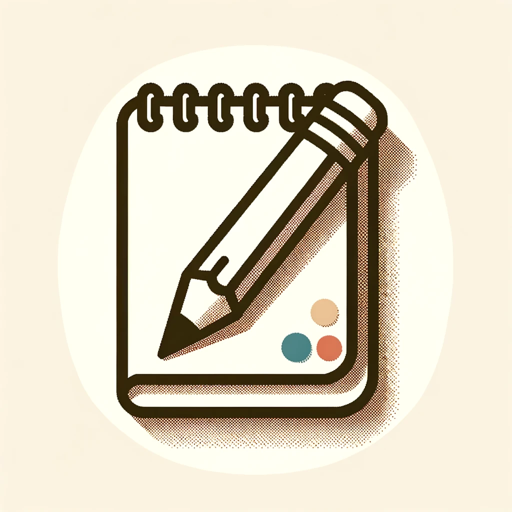BIDARA - Biomimicry Design Assistant-biomimicry-inspired design solutions
AI-powered biomimicry design assistant
Tell me about the Biomimicry Design Process.
What is BIDARA?
How do you biologize a problem?
What is the biomimicry design spiral?
Related Tools
Load More
Software Architect
Software Architect is a tool for simplifying software development for everyone, especially non-professionals, particularly in architecture design. It supports forms like C, Java, scripting, low-code, cloud-native, and more, offering language and framework

Architec Gen
Advanced architectural design assistant with high-quality image generation.

InventBot
Create Futuristic Inventions

Archi
Fantastic Architecture Visualizer
Bioengineer
An expert in bioengineering, skilled in logical problem-solving

Design Innovator
Global Leader in Product Design & Innovation
20.0 / 5 (200 votes)
Introduction to BIDARA - Biomimicry Design Assistant
BIDARA, the Biomimicry Design Assistant, is designed to facilitate the biomimicry design process, helping users explore and apply nature-inspired strategies to solve human challenges. It leverages the Biomimicry Design Spiral, a structured approach to translating biological insights into innovative design solutions. BIDARA's purpose is to guide users through key steps, from defining a design challenge to evaluating solutions, providing support and resources at each stage. For instance, when a company wants to develop a new water filtration system, BIDARA can help them explore natural filtration mechanisms, such as how mangroves filter saltwater, and guide them in adapting these strategies to create efficient, sustainable filters. BIDARA serves as a bridge between nature's wisdom and human design, making it easier for designers, engineers, and innovators to think creatively and sustainably.

Main Functions of BIDARA - Biomimicry Design Assistant
Define the Challenge
Example
A team developing eco-friendly packaging uses BIDARA to clearly articulate their goal of reducing plastic waste and set criteria for success, such as biodegradability and strength.
Scenario
BIDARA guides users in defining their design challenge by framing it in the right context and ensuring the problem is well understood before moving forward. This step involves setting clear impact goals and constraints to focus the design process.
Biologize Function & Context
Example
A startup designing a cooling system for urban buildings uses BIDARA to reframe their challenge: 'How does nature regulate temperature in hot climates?' This guides their research towards natural models like termite mounds.
Scenario
BIDARA helps translate human design challenges into biologically relevant questions, allowing users to 'ask nature' for strategies that can be emulated. This step focuses on identifying the core functions needed and finding analogous natural solutions.
Discover Biological Strategies
Example
An architect uses BIDARA to research how plants in arid environments manage water retention. They find inspiration in the structure of cactus spines and incorporate similar design principles into building materials.
Scenario
BIDARA aids users in identifying biological models that solve similar challenges, providing access to a wealth of biological strategies and examples. This step emphasizes exploration and learning from multiple species and ecosystems.
Abstract Design Strategies
Example
A fashion designer looks for ways to create a self-cleaning fabric. BIDARA helps them study the lotus leaf’s microstructures and translate that strategy into a textile design that repels dirt and water.
Scenario
BIDARA guides the user to distill the essence of biological strategies into practical, non-biological terms that can be used across disciplines. This abstraction helps in developing versatile design concepts that draw from nature.
Emulate Nature’s Lessons
Example
A robotics team designing a new prosthetic limb uses BIDARA to emulate the structure and flexibility of an octopus tentacle, creating a limb with improved range of motion.
Scenario
BIDARA supports the development of design concepts by applying nature’s lessons directly to the user’s challenge, fostering creative, functional, and sustainable solutions.
Evaluate Fit and Functionality
Example
An automotive company tests a biomimetic car paint that mimics shark skin to reduce drag. BIDARA provides a framework to assess the new paint’s performance in various environmental conditions.
Scenario
BIDARA helps users evaluate their design concepts against the original criteria and natural principles, considering technical feasibility, market fit, and sustainability. This iterative process ensures continuous improvement and refinement.
Ideal Users of BIDARA - Biomimicry Design Assistant
Designers and Architects
Designers and architects can use BIDARA to incorporate biomimetic principles into their projects, creating innovative, sustainable solutions that draw from nature. For example, architects may look to natural structures like termite mounds for passive cooling strategies in building designs.
Engineers and Product Developers
Engineers and product developers benefit from BIDARA by using it to find nature-inspired strategies for material selection, structure, and functionality. For example, an engineer might use BIDARA to discover how mollusk shells resist impact and apply similar strategies to develop stronger materials for helmets or vehicles.
Educators and Students
Educators and students can utilize BIDARA as an educational tool to explore the principles of biomimicry and learn how to apply these concepts to real-world challenges. It offers a hands-on approach to understanding nature's strategies, fostering a deeper appreciation of sustainability in design.

How to use BIDARA - Biomimicry Design Assistant
Visit aichatonline.org
Access BIDARA for free without login, and no need for ChatGPT Plus. Explore the features immediately after visiting the site.
Define the Design Challenge
Begin by clearly articulating your challenge. BIDARA assists you in breaking down the challenge to identify key functions and constraints following the Biomimicry Design Spiral【19†source】.
Biologize the Problem
Reframe the challenge in biological terms to 'ask nature' for insights. This helps in aligning human design problems with nature’s solutions【20†source】.
Explore Biological Strategies
Use BIDARA’s extensive biological database or tools like AskNature to discover biological models that address similar functional challenges【23†source】.
Emulate and Iterate
Emulate nature’s strategies to design your solution, evaluate fit and function, and refine your approach as needed. Iterate through steps based on new findings【21†source】【16†source】.
Try other advanced and practical GPTs
Ai Text Generator for Creative Writing
Empower your creativity with AI-driven writing.

Da Vinci Device - Student Companion
Empowering Students with AI Insight

Parsers VC - Weekly Venture Report
AI-Powered Insights for Venture Markets

On Page SEO
AI-powered On Page SEO Optimization

SEO Copywriting
AI-powered SEO content creation

Drip Check | Rate My Outfit & Fashion Sense 💧
AI-powered outfit rating and fashion feedback

Enhanced UX Writer GPT
AI-powered tool for user-centered content

AUDRI001
Boost Your LinkedIn with AI

Prompt Coach - Nghiện AI
AI-Powered Prompt Optimization.

All-Bot - Proteus v6
AI-powered assistant for diverse tasks.

1 A.I. Date Planner
AI-powered date ideas, tailored for you

App Icon Creator
Create stunning app icons with AI.
- Problem Solving
- Creative Design
- Nature Analysis
- Strategy Discovery
- Sustainability Research
Q&A on BIDARA - Biomimicry Design Assistant
What is BIDARA's primary function?
BIDARA helps users solve design challenges by mimicking strategies from nature. It guides through the Biomimicry Design Spiral, translating biological insights into practical solutions【19†source】【20†source】.
How does BIDARA assist in defining a design problem?
BIDARA helps you define your challenge by asking 'How might we?' questions. This step refines the design scope, clarifying the function and context【19†source】.
Can BIDARA help discover biological solutions?
Yes. BIDARA connects you with databases like AskNature to explore relevant biological models and strategies based on your design problem【23†source】.
What is the Biomimicry Design Spiral?
The Biomimicry Design Spiral is an iterative process of defining a challenge, biologizing it, discovering natural strategies, abstracting insights, emulating nature, and evaluating designs【16†source】【17†source】.
How does BIDARA ensure the design solutions are life-friendly?
BIDARA guides you to evaluate your designs against nature’s unifying patterns and earth’s ecosystems, ensuring sustainable, life-friendly solutions【21†source】【18†source】.